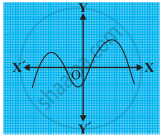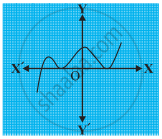Advertisements
Advertisements
Question
The graphs of y = p(x) are given in following figure, for some polynomials p(x). Find the number of zeroes of p(x).

Solution
The graph intersects x-axis at four point.
∴ The no of zeroes of p(x) is four.
APPEARS IN
RELATED QUESTIONS
The graphs of y = p(x) are given in following figure, for some polynomials p(x). Find the number of zeroes of p(x).

The graphs of y = p(x) are given in following figure, for some polynomials p(x). Find the number of zeroes of p(x).

One zero of the polynomial `3x^3+16x^2 +15x-18 is 2/3` . Find the other zeros of the polynomial.
Obtain all other zeroes of `(x^4 + 4x^3 – 2x^2 – 20x – 15)` if two of its zeroes are `sqrt5 and –sqrt5.`
If one zero of the quadratic polynomial `kx^2 + 3x + k is 2`, then find the value of k.
Write the zeros of the polynomial `f(x) = x^2 – x – 6`.
If ∝ and β are the zeros of the polynomial f(x) = `6x^2 + x - 2 `find the value of `(∝/β+∝/β) `
If one zero of the quadratic polynomial x2 + 3x + k is 2, then the value of k is ______.
A quadratic polynomial, whose zeroes are -3 and 4, is ______.
Given that one of the zeroes of the cubic polynomial ax3 + bx2 + cx + d is zero, the product of the other two zeroes is ______.
10. The zeroes of the quadratic polynomial x² + kx + k, k? 0.
If the zeroes of the quadratic polynomial ax² + bx + c, c # 0 are equal, then ______.
The zeroes of the quadratic polynomial x² + 1750x + 175000 are ______.
If one of the zeroes of the quadratic polynomial (k -1)x² + kx + 1 the value of k is ______.
If 4x² – 6x – m is divisible by x – 3, the value of m is exact divisor of ______.
If the graph of a polynomial intersects the x-axis at only one point, it cannot be a quadratic polynomial.
If the graph of a polynomial intersects the x-axis at exactly two points, it need not be a quadratic polynomial.
The zeroes of the quadratic polynomial x2 + kx + k, k ≠ 0 ______.
If α and β are the zeroes of the polynomial x2 + x − 2, then find the value of `alpha/beta+beta/alpha`
